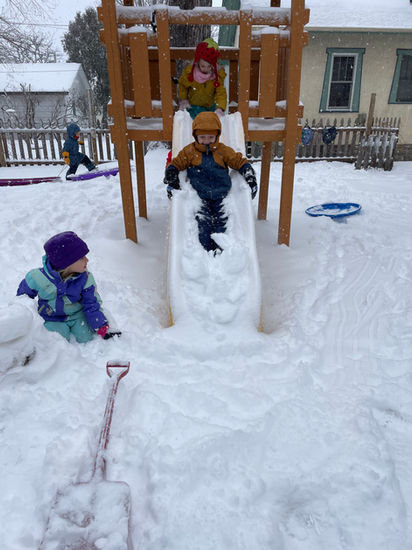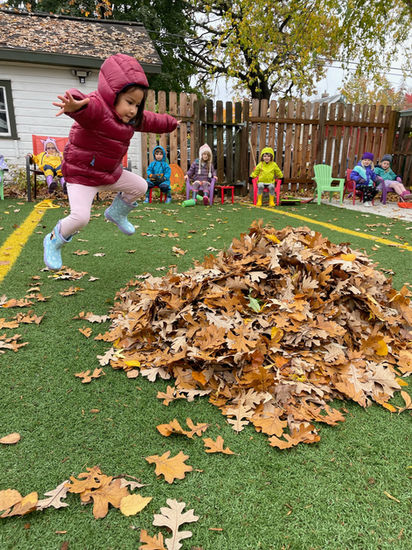Nokomis Neighborhood Preschool
About Nokomis Neighborhood Preschool
At Nokomis Neighborhood Preschool, we believe in the power of discovery-based play as a means for children to tap into their natural sense of joy and wonder. Our entire home has been converted into a loving, nurturing learning environment, featuring dedicated rooms for Dramatic Play, Art, Natural Sciences, Literacy, Math concepts, Puzzles, and Blocks. We are committed to providing a space where children can explore, learn, and grow.


Meet Alyssa
Alyssa is a cherished member of our preschool community, bringing over 20 years of experience in early childhood education. Her passion for nurturing young minds and fostering a love for learning is evident in every interaction she has with her students. Alyssa's extensive experience allows her to create a warm, engaging, and supportive environment where children thrive both socially and emotionally.
Credentials and License
Alyssa is a licensed preschool teacher in Hennepin County, Minnesota, which signifies her commitment to maintaining the highest standards of safety and education. Being licensed in this county involves rigorous requirements, ensuring that educators are well-equipped to provide a safe and enriching environment for children. Including, but not limited to...
Health and Safety: Alyssa prioritizes the health and well-being of her students by maintaining a clean and hygienic classroom environment. She is knowledgeable about first aid and emergency response, ensuring children are cared for in any situation.
Street Safety: Alyssa is trained to teach children about the importance of street safety, incorporating lessons on how to safely navigate crosswalks and understand traffic signals. This knowledge is crucial for children's safety outside the classroom.
Fire Safety: Alyssa conducts regular fire drills and educates children on fire safety protocols, ensuring they know how to respond calmly and efficiently in case of an emergency.
Storm Safety: Understanding the unpredictability of weather, Alyssa is well-versed in storm safety procedures. She teaches children how to stay safe during severe weather conditions, providing peace of mind to parents.
Continuing Education: To maintain her license, Alyssa participates in ongoing professional development. This commitment to continuing education allows her to stay updated on the latest teaching strategies and safety protocols, ensuring she provides the best possible care and education to her students. Alyssa's dedication to her students and her extensive knowledge of safety and education standards make her an invaluable asset to our preschool. Her nurturing approach and commitment to excellence ensure that every child in her care feels loved, supported, and inspired to learn.
What We Do
Preschool Curriculum
Our preschool curriculum is designed to foster creativity, critical thinking, and social development. Through engaging activities and hands-on experiences, we guide children in exploring their interests and developing essential skills.
Enrichment Activities
We offer a variety of enrichment activities that complement our preschool program, including music, games, dress up, art, and movement. These activities provide additional opportunities for children to learn and express themselves.
Parent Partnership
We believe in the importance of parental involvement in a child's early education. Our partnership with parents ensures that each child receives the support and encouragement they need to thrive.
Class Schedule
Classes are filling fast for 2025-2026. Please contact us to schedule a tour or be put on our waiting list. Schedule a tour.
2025-2026 Class Pricing
Morning Classes 9:00am – 12:00pm
2 days (T Th): $345/mo
3 days (M W F): $455/mo
4 days (M-Th): $585/mo
5 days (M-F): $720/mo
Afternoon Classes 1:00pm – 4:00pm
Call for availability
Lunch Bunch available on Monday through Friday for an additional $14/day.
*No infant care

A Typical Day
Our preschool is a place where childhood joy and learning go hand in hand. We believe in nurturing a loving environment where children can develop essential social and emotional skills. Here's a glimpse of what a typical day looks like:
• 9:00 AM - Drop Off and Learning Centers: As children arrive, they are greeted with warm smiles and open arms by our dedicated teachers. This welcoming atmosphere sets the tone for a day filled with exploration and fun.Children engage in a variety of hands-on activities that stimulate creativity and critical thinking. Our 6:1 student-to-teacher ratio ensures personalized attention, allowing each child to explore at their own pace.
• 10:30 AM - Group Time: We gather together to sing songs, share stories, and discuss the day's exciting activities. This time helps children build a sense of community and enhances their communication skills.
• 10:45 AM - Snack Time A healthy snack is provided...
• 11:00 AM - Outdoor Play: Fresh air and physical activity are crucial for young learners. Our playground offers a safe space for children to run, climb, and play, fostering physical development and teamwork.
• 12:00 PM - Pick Up: With hearts full of joy and minds enriched with new experiences, children are ready to reunite with their families. Our teachers ensure a smooth transition from school to home, sharing highlights of the day with parents.
• 12:00 PM - 1:00 PM - Lunch Bunch (Optional): Families can choose to enroll their children in our Lunch Bunch program for an additional $14 per day. During this hour, children enjoy their family-provided lunches while socializing with friends under the guidance of our caring staff.
At our preschool, every day is an opportunity for children to grow, learn, and experience the joy of childhood in a loving and supportive environment.
Parent Testimonials
Photo Gallery
1:00 – 4:00























